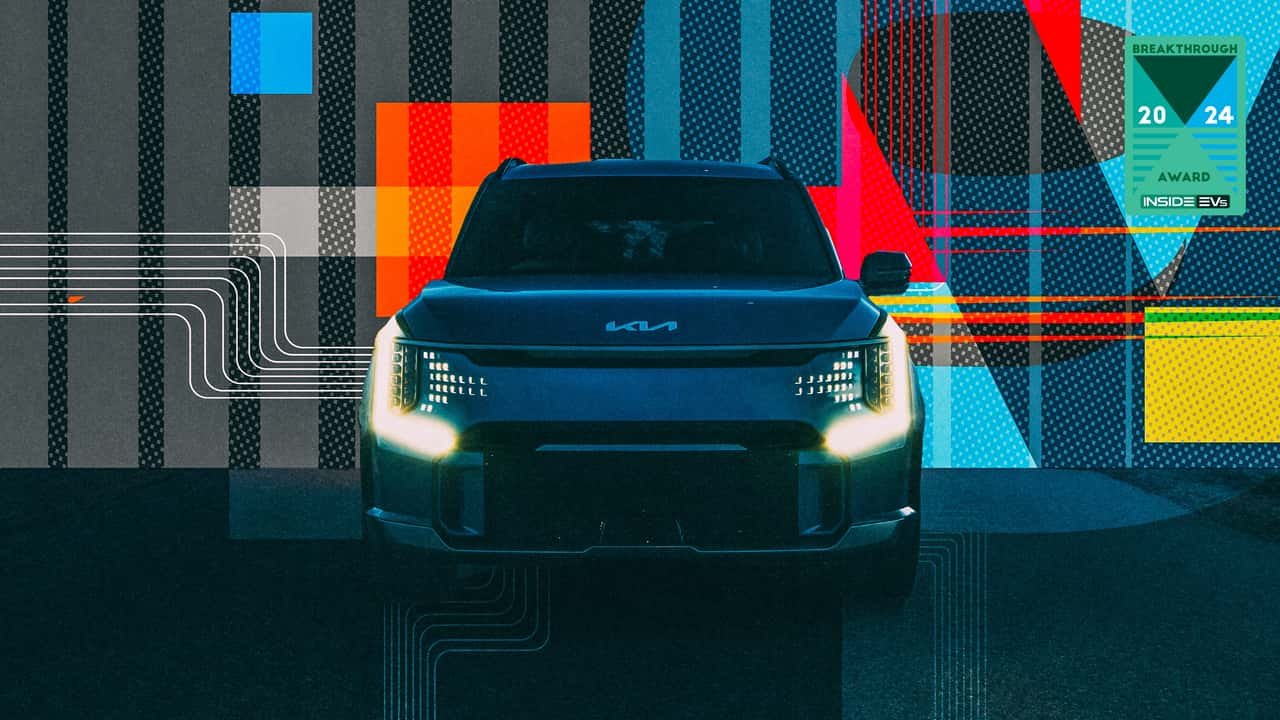The three-row EV from Kia is an amazing vehicle and a significant accomplishment. Was this sufficient to help it win?
Americans are tired of making significant sacrifices in order to purchase an electric vehicle, if the past year’s rocky growth in this market is any indication. They will most likely just buy a hybrid or a regular gas car and be done with it if the current models are too expensive, too small, or have insufficient range.
Rich geeks lining up to purchase anything and everything electric is a thing of the past.
The good news for consumers is that the list of compromises required to switch to electric power is getting less every day. Just take a look at the Kia EV9, a sleek three-row SUV that has single-handedly opened up the world of EVs to a whole new type of buyer.
Have you smelled that? It sounds like a breakthrough.
The Reasons The EV9 Is Revolutionary
Prior to the release of the EV9, American families with limited options for an electric three-row SUV had few options. Every aspect was either strange, costly, cramped, or a mix of all three. Take the expensive Rivian R1S, the expensive Mercedes-Benz EQS SUV, and the egg-shaped Tesla Model X.
According to Kevin Williams, a staff writer for InsideEVs, “It’s crazy that every three-row EV has some weird caveat.”
For those who cherished their Toyota Highlander or Kia Telluride and desired something similar, there just wasn’t a popular, reasonably priced choice. And that leads us to the innovation of the EV9: Being the first mass-market three-row electric SUV, it electrifies a very popular car market in a way that no other vehicle has done previously.
The Kia EV9 can accommodate adults in all three rows and still fit a lot of their belongings.
It seeks to remove one of the most important but often disregarded obstacles to broader EV adoption. If they can’t even locate an EV in the basic form factor they want to buy, buyers won’t even start to address their concerns about charging infrastructure, range, or cost of ownership.
There are too many battery-powered solutions available in some categories. There are just as many electric pickup truck models available in America now as there are full-size gas-powered vehicles. About 20 high-end electric crossovers are available from brands like Audi, Porsche, Lexus, and others. Unfortunately, full-size electric three-rows have been neglected.
With the 2024 EV9, which starts at $56,395 and is available in roomy six- and seven-seater versions, Kia filled that void. Although it’s not precisely inexpensive—we’ll talk about that later—its introduction reduced the starting price of a three-row EV by about $20,000 overnight. You also receive a lot of value for your money. When compared to both gas and electric competition, the EV9 is quite attractive due to its impressive appearance, superior technology, strong range, and industry-leading charging speeds.
According to InsideEVs Deputy Editor Mack Hogan, “The Kia EV9 is the mainstream option with the best design and best tech if you want a three-row SUV of any type today.” “Its electric nature is a benefit.”
This is the first three-row family crossover that isn’t difficult to drive, and Patrick George is correct.
In contrast to the Rivian R1S, we adored its spacious third row. Its highway driver-assistance technology, which often keeps up with oncoming traffic and follows lane lines neatly, was lauded by many. One criticism is that, in contrast to GM’s Super Cruise and Ford’s BlueCruise, it is still a hands-on system. According to Kia, long-range EV9 models can charge from 10 to 80% in just 24 minutes, making them charging champions as well. During a road trip, I quickly charged my tester from 18 to 80% in 22 minutes, reaching 216 kilowatts and validating the carmaker’s claims.
Generally speaking, we had no significant issues with the EV9’s quiet and comfortable ride. Regardless of its power source, InsideEVs Editor-in-Chief Patrick George claimed it drove the best of any large SUV he has tried.
“I’ll tell you the dirty secret about the three-row crossover: even though Americans adore them, they’re terrible to drive,” he added. “The Kia EV9 is the only exception to this rule.”
Still, certain complaints were raised repeatedly. Despite its aesthetic appeal, the steering wheel totally hides the touch-based climate control panel. An EPA-estimated range of 230 miles is quite fine in base configuration. However, we eventually chose not to award the EV9 in our first Breakthrough EV of the Year competition because of those minor grievances.
Why It Doesn’t Win for Us
It’s difficult to ignore the EV9’s cost in comparison to its gas-powered competitors, despite the fact that it marks a significant advancement for a crucial market. You may get a Telluride for as little as $37,585, which includes the destination charge. Putting aside for a moment the incredible lease offers that have sprung up as a result of the “leasing loophole” in the federal EV tax credit, it is about $20,000 less than the most affordable EV9.
The gap is further widened by must-have features. When the long-range battery pack is added, the SUV’s range increases to 304 miles, and its cost rises to slightly over $60,000. If you add a second motor for all-wheel drive, the cost will exceed $65,000. For instance, the GT-Line model I tested with all the bells and whistles cost $80,000.
The cost of the EV9 places it in competition with vehicles such as the Chevy Tahoe. Although competing three-row crossovers are far less expensive, we would definitely choose the Kia.







